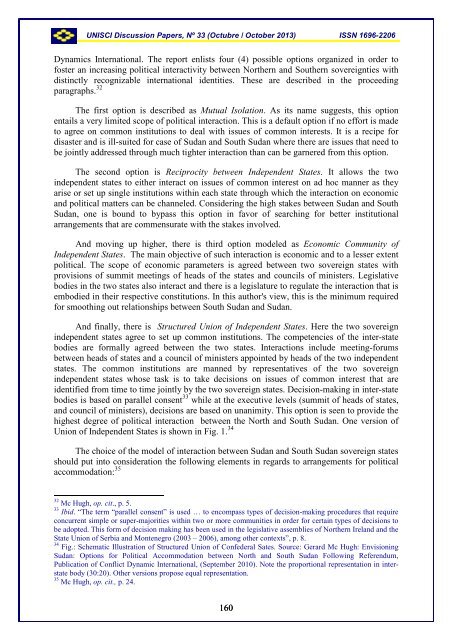UNISCI - Universidad Complutense de Madrid
UNISCI - Universidad Complutense de Madrid
UNISCI - Universidad Complutense de Madrid
You also want an ePaper? Increase the reach of your titles
YUMPU automatically turns print PDFs into web optimized ePapers that Google loves.
<strong>UNISCI</strong> Discussion Papers, Nº 33 (Octubre / October 2013) ISSN 1696-2206Dynamics International. The report enlists four (4) possible options organized in or<strong>de</strong>r tofoster an increasing political interactivity between Northern and Southern sovereignties withdistinctly recognizable international i<strong>de</strong>ntities. These are <strong>de</strong>scribed in the proceedingparagraphs. 32The first option is <strong>de</strong>scribed as Mutual Isolation. As its name suggests, this optionentails a very limited scope of political interaction. This is a <strong>de</strong>fault option if no effort is ma<strong>de</strong>to agree on common institutions to <strong>de</strong>al with issues of common interests. It is a recipe fordisaster and is ill-suited for case of Sudan and South Sudan where there are issues that need tobe jointly addressed through much tighter interaction than can be garnered from this option.The second option is Reciprocity between In<strong>de</strong>pen<strong>de</strong>nt States. It allows the twoin<strong>de</strong>pen<strong>de</strong>nt states to either interact on issues of common interest on ad hoc manner as theyarise or set up single institutions within each state through which the interaction on economicand political matters can be channeled. Consi<strong>de</strong>ring the high stakes between Sudan and SouthSudan, one is bound to bypass this option in favor of searching for better institutionalarrangements that are commensurate with the stakes involved.And moving up higher, there is third option mo<strong>de</strong>led as Economic Community ofIn<strong>de</strong>pen<strong>de</strong>nt States. The main objective of such interaction is economic and to a lesser extentpolitical. The scope of economic parameters is agreed between two sovereign states withprovisions of summit meetings of heads of the states and councils of ministers. Legislativebodies in the two states also interact and there is a legislature to regulate the interaction that isembodied in their respective constitutions. In this author's view, this is the minimum requiredfor smoothing out relationships between South Sudan and Sudan.And finally, there is Structured Union of In<strong>de</strong>pen<strong>de</strong>nt States. Here the two sovereignin<strong>de</strong>pen<strong>de</strong>nt states agree to set up common institutions. The competencies of the inter-statebodies are formally agreed between the two states. Interactions inclu<strong>de</strong> meeting-forumsbetween heads of states and a council of ministers appointed by heads of the two in<strong>de</strong>pen<strong>de</strong>ntstates. The common institutions are manned by representatives of the two sovereignin<strong>de</strong>pen<strong>de</strong>nt states whose task is to take <strong>de</strong>cisions on issues of common interest that arei<strong>de</strong>ntified from time to time jointly by the two sovereign states. Decision-making in inter-statebodies is based on parallel consent 33 while at the executive levels (summit of heads of states,and council of ministers), <strong>de</strong>cisions are based on unanimity. This option is seen to provi<strong>de</strong> thehighest <strong>de</strong>gree of political interaction between the North and South Sudan. One version ofUnion of In<strong>de</strong>pen<strong>de</strong>nt States is shown in Fig. 1. 34The choice of the mo<strong>de</strong>l of interaction between Sudan and South Sudan sovereign statesshould put into consi<strong>de</strong>ration the following elements in regards to arrangements for politicalaccommodation: 3532 Mc Hugh, op. cit., p. 5.33 Ibid. “The term “parallel consent” is used … to encompass types of <strong>de</strong>cision-making procedures that requireconcurrent simple or super-majorities within two or more communities in or<strong>de</strong>r for certain types of <strong>de</strong>cisions tobe adopted. This form of <strong>de</strong>cision making has been used in the legislative assemblies of Northern Ireland and theState Union of Serbia and Montenegro (2003 – 2006), among other contexts”, p. 8.34 Fig.: Schematic Illustration of Structured Union of Confe<strong>de</strong>ral Sates. Source: Gerard Mc Hugh: EnvisioningSudan: Options for Political Accommodation between North and South Sudan Following Referendum,Publication of Conflict Dynamic International, (September 2010). Note the proportional representation in interstatebody (30:20). Other versions propose equal representation.35 Mc Hugh, op. cit., p. 24.160
















